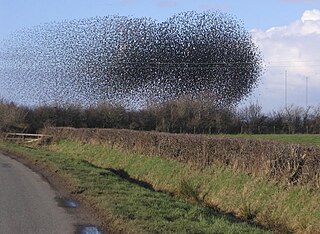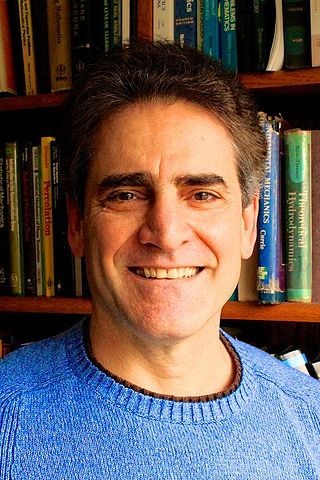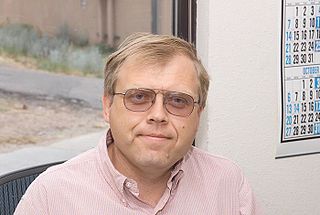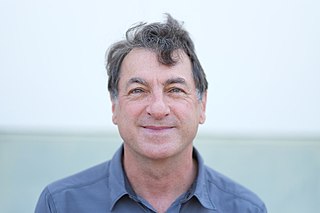Related Research Articles

In condensed matter physics and materials science, an amorphous solid is a solid that lacks the long-range order that is characteristic of a crystal. The terms "glass" and "glassy solid" are sometimes used synonymously with amorphous solid; however, these terms refer specifically to amorphous materials that undergo a glass transition. Examples of amorphous solids include glasses, metallic glasses, and certain types of plastics and polymers.

An amorphous metal is a solid metallic material, usually an alloy, with disordered atomic-scale structure. Most metals are crystalline in their solid state, which means they have a highly ordered arrangement of atoms. Amorphous metals are non-crystalline, and have a glass-like structure. But unlike common glasses, such as window glass, which are typically electrical insulators, amorphous metals have good electrical conductivity and can show metallic luster.
Chalcogenide glass is a glass containing one or more chalcogens. Such glasses are covalently bonded materials and may be classified as covalent network solids. Polonium is also a chalcogen but is not used because of its strong radioactivity. Chalcogenide materials behave rather differently from oxides, in particular their lower band gaps contribute to very dissimilar optical and electrical properties.
In materials science, paracrystalline materials are defined as having short- and medium-range ordering in their lattice but lacking crystal-like long-range ordering at least in one direction.
Amorphous calcium phosphate (ACP) is a glassy solid that is formed from the chemical decomposition of a mixture of dissolved phosphate and calcium salts (e.g. (NH4)2HPO4 + Ca(NO3)2). The resulting amorphous mixture consists mostly of calcium and phosphate, but also contains varying amounts of water and hydrogen and hydroxide ions, depending on the synthesis conditions. Such mixtures are also known as calcium phosphate cement.
The glass–liquid transition, or glass transition, is the gradual and reversible transition in amorphous materials from a hard and relatively brittle "glassy" state into a viscous or rubbery state as the temperature is increased. An amorphous solid that exhibits a glass transition is called a glass. The reverse transition, achieved by supercooling a viscous liquid into the glass state, is called vitrification.
Daniel L. Stein is an American physicist and Professor of Physics and Mathematics at New York University. From 2006 to 2012 he served as the NYU Dean of Science.

Active matter is matter composed of large numbers of active "agents", each of which consumes energy in order to move or to exert mechanical forces. Such systems are intrinsically out of thermal equilibrium. Unlike thermal systems relaxing towards equilibrium and systems with boundary conditions imposing steady currents, active matter systems break time reversal symmetry because energy is being continually dissipated by the individual constituents. Most examples of active matter are biological in origin and span all the scales of the living, from bacteria and self-organising bio-polymers such as microtubules and actin, to schools of fish and flocks of birds. However, a great deal of current experimental work is devoted to synthetic systems such as artificial self-propelled particles. Active matter is a relatively new material classification in soft matter: the most extensively studied model, the Vicsek model, dates from 1995.

Salvatore Torquato is an American theoretical scientist born in Falerna, Italy. His research work has impacted a variety of fields, including physics, chemistry, applied and pure mathematics, materials science, engineering, and biological physics. He is the Lewis Bernard Professor of Natural Sciences in the Department of Chemistry and Princeton Institute for the Science and Technology of Materials at Princeton University. He has been a Senior Faculty Fellow in the Princeton Center for Theoretical Science, an enterprise dedicated to exploring frontiers across the theoretical natural sciences. He is also an Associated Faculty Member in three departments or programs at Princeton University: Physics, Program in Applied and Computational Mathematics, and Mechanical & Aerospace Engineering. On multiple occasions, he was a Member of the School of Mathematics as well as the School of Natural Sciences at the Institute for Advanced Study, Princeton, New Jersey.

Alexander V. Balatsky is a USSR-born American physicist. He is the professor of theoretical physics at NORDITA and University of Connecticut. He served as the founding director of the Institute for Materials Science (IMS) at Los Alamos National Laboratory in 2014–2017.
Bernhard Keimer is a German physicist and Director at the Max Planck Institute for Solid State Research. His research group uses spectroscopic methods to explore quantum many-body phenomena in correlated-electron materials and metal-oxide heterostructures.
Hyperuniform materials are characterized by an anomalous suppression of density fluctuations at large scales. More precisely, the vanishing of density fluctuations in the long-wave length limit distinguishes hyperuniform systems from typical gases, liquids, or amorphous solids. Examples of hyperuniformity include all perfect crystals, perfect quasicrystals, and exotic amorphous states of matter.

Maria Cristina Marchetti is an Italian-born, American theoretical physicist specializing in statistical physics and condensed matter physics. In 2019, she received the Leo P. Kadanoff Prize of the American Physical Society. She held the William R. Kenan, Jr. Distinguished Professorship of Physics at Syracuse University, where she was the director of the Soft and Living Matter program, and chaired the department 2007–2010. She is currently Professor of Physics at the University of California, Santa Barbara.
Bulbul Chakraborty is the Enid and Nate Ancell Professor of Physics at Brandeis University. She is recognized for her contributions to soft condensed matter theory studying systems far from equilibrium, such as granular materials, amorphous systems, and statistical physics. She is an elected American Physical Society and American Association for the Advancement of Science fellow.
Pablo Jarillo-Herrero is a Spanish physicist and current Cecil and Ida Green Professor of Physics at Massachusetts Institute of Technology (MIT).
Alessio Zaccone is an Italian physicist.

Mark John Bowick is a theoretical physicist in condensed matter theory and high energy physics. He is the deputy director of the Kavli Institute for Theoretical Physics at the University of California, Santa Barbara, and a Visiting Distinguished Professor of Physics in UCSB's Physics Department.
Jennifer L. Ross is an American physicist who is Professor and Chair of the Department of Physics at Syracuse University. Her research considers active biological condensed matter physics. She was elected fellow of the American Physical Society in 2018 and American Association for the Advancement of Science in 2022.
Arthur Alan Middleton is a professor of Physics and the associate dean of the College of Arts and Sciences at Syracuse University. He is known for his work in the fields of disordered materials such as random magnets, spin glasses, and interfaces in a random environment, transport in disordered materials, interface motion, and colloidal assemblies, condensed matter physics, statistical physics, and computational physics, connections between algorithm dynamics, computer science analyses, algorithms for efficient simulation of complex dynamics, including heuristic coarse graining for glassy materials.

Matthieu Wyart is a French physicist. He is a professor of physics at EPFL and the head of the Physics of Complex Systems Laboratory.
References
- 1 2 "M. Lisa Manning, professor of physics and founding director of BioInspired Syracuse: Institute for Material and Living Systems, has been named the William R. Kenan, Jr., Professor of Physics. This highly selective professorship was established in 1971 by". College of Arts & Sciences at Syracuse University. Retrieved 2020-06-22.
- ↑ "Lisa Manning - Jefferson Scholars Foundation". www.jeffersonscholars.org.
- ↑ Effective temperature and strain localization in amorphous solids (PhD thesis). University of California, Santa Barbara. ISBN 9780549842576 . Retrieved 2022-09-01.
- ↑ "The Physics of Glass Opens a Window Into Biology - Quanta Magazine". 11 June 2018.
- ↑ Manning, M. Lisa; Foty, Ramsey A.; Steinberg, Malcolm S.; Schoetz, Eva-Maria (13 July 2010). "Coaction of intercellular adhesion and cortical tension specifies tissue surface tension". Proceedings of the National Academy of Sciences. 107 (28): 12517–12522. Bibcode:2010PNAS..10712517M. doi: 10.1073/pnas.1003743107 . PMC 2906578 . PMID 20616053.
- ↑ Merkel, Matthias; Manning, Lisa (2017). "A geometrically controlled rigidity transition in a model for confluent 3D tissues". New Journal of Physics. 20 (2): 022002. arXiv: 1706.02656 . doi:10.1088/1367-2630/aaaa13. S2CID 3867697.
- ↑ Merkel, Matthias; Manning, Lisa; Schwarz, J. M; Manning, M. Lisa (2013). "Energy barriers govern glassy dynamics in tissues". Soft Matter. 10 (12): 1885–90. arXiv: 1308.3891 . doi:10.1039/c3sm52893f. PMID 24652538.
- ↑ Amack, Jeffrey D.; Manning, M. Lisa (12 October 2012). "Knowing the Boundaries: Extending the Differential Adhesion Hypothesis in Embryonic Cell Sorting". Science. 338 (6104): 212–215. Bibcode:2012Sci...338..212A. doi:10.1126/science.1223953. PMID 23066072. S2CID 206542264.
- ↑ Yang, Xingbo; Bi, Dapeng; Czajkowski, Michael; Merkel, Matthias; Manning, M. Lisa; Marchetti, M. Cristina (28 November 2017). "Correlating cell shape and cellular stress in motile confluent tissues". Proceedings of the National Academy of Sciences. 114 (48): 12663–12668. arXiv: 1704.05951 . Bibcode:2017PNAS..11412663Y. doi: 10.1073/pnas.1705921114 . PMC 5715741 . PMID 29138312.
- ↑ "Jammed Cells Expose the Physics of Cancer". Quanta Magazine. 16 August 2016.
- ↑ Merkel, Matthias; Manning, Lisa (2015). "Disentangling defects and sound modes in disordered solids". arXiv: 1502.00685 [cond-mat.soft].
- ↑ Merkel, Matthias; Manning, Lisa; Porter, M. A; Manning, M. L; Daniels, K. E (2015). "Extraction of Force-Chain Network Architecture in Granular Materials Using Community Detection". Soft Matter. 11 (14): 2731–44. arXiv: 1408.3841 . Bibcode:2015SMat...11.2731B. doi:10.1039/c4sm01821d. PMID 25703651. S2CID 18154269.
- ↑ Merkel, Matthias; Manning, Lisa (2015). "A random matrix definition of the boson peak". EPL. 109 (36002): 36002. arXiv: 1307.5904 . Bibcode:2015EL....10936002M. doi:10.1209/0295-5075/109/36002. S2CID 21737384.
- ↑ Cunningham, Aimee (28 September 2018). "Lisa Manning describes the physics of how cells move".
- ↑ "Materials, like metallic glass, can help us understand how cells break - NSF - National Science Foundation". www.nsf.gov.
- ↑ "Immersive DNA force sensors and predictive mechanical modeling for tissue morphogenesis - Scialog: Collaborative Teams - Research Corporation for Science Advancement". Research Corporation for Science Advancement.
- ↑ "M. Lisa Manning - Cottrell Scholar Awards - Research Corporation for Science Advancement". Research Corporation for Science Advancement.
- ↑ "Lisa Manning - Simons Foundation". Simons Foundation. 13 July 2017.
- ↑ "C3: News - IUPAP: The International Union of Pure and Applied Physics". iupap.org. 8 March 2021.
- ↑ "2018 Stanley Corrsin Award Recipient". www.aps.org.